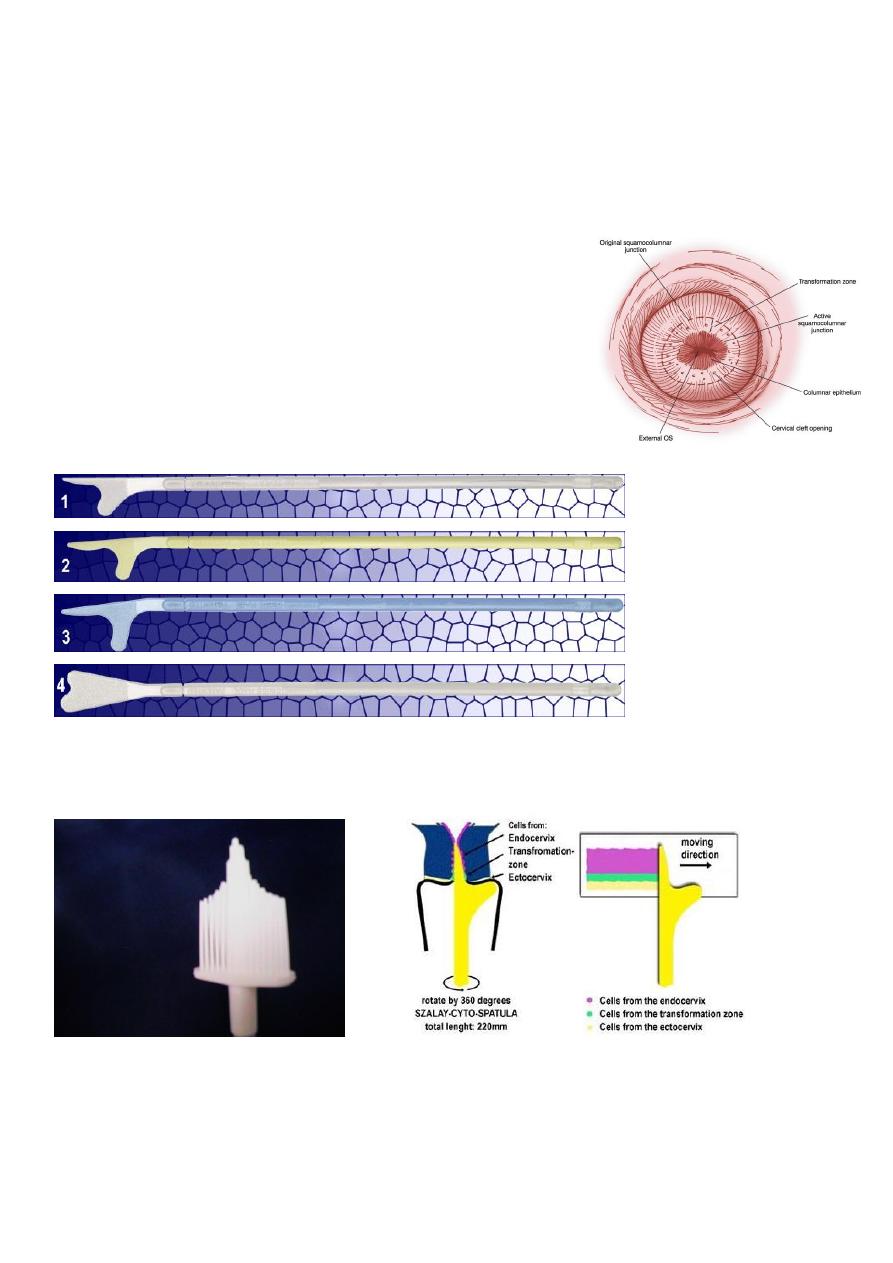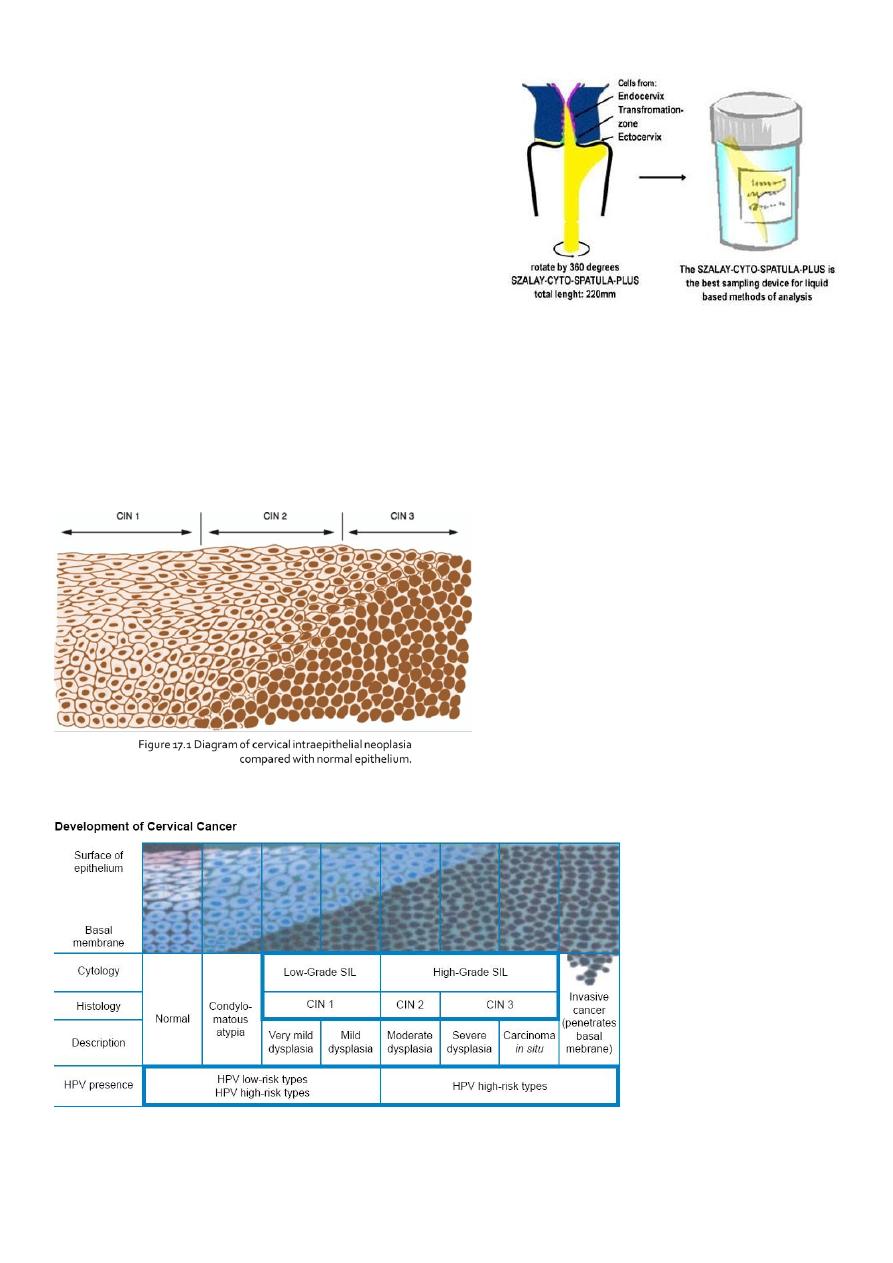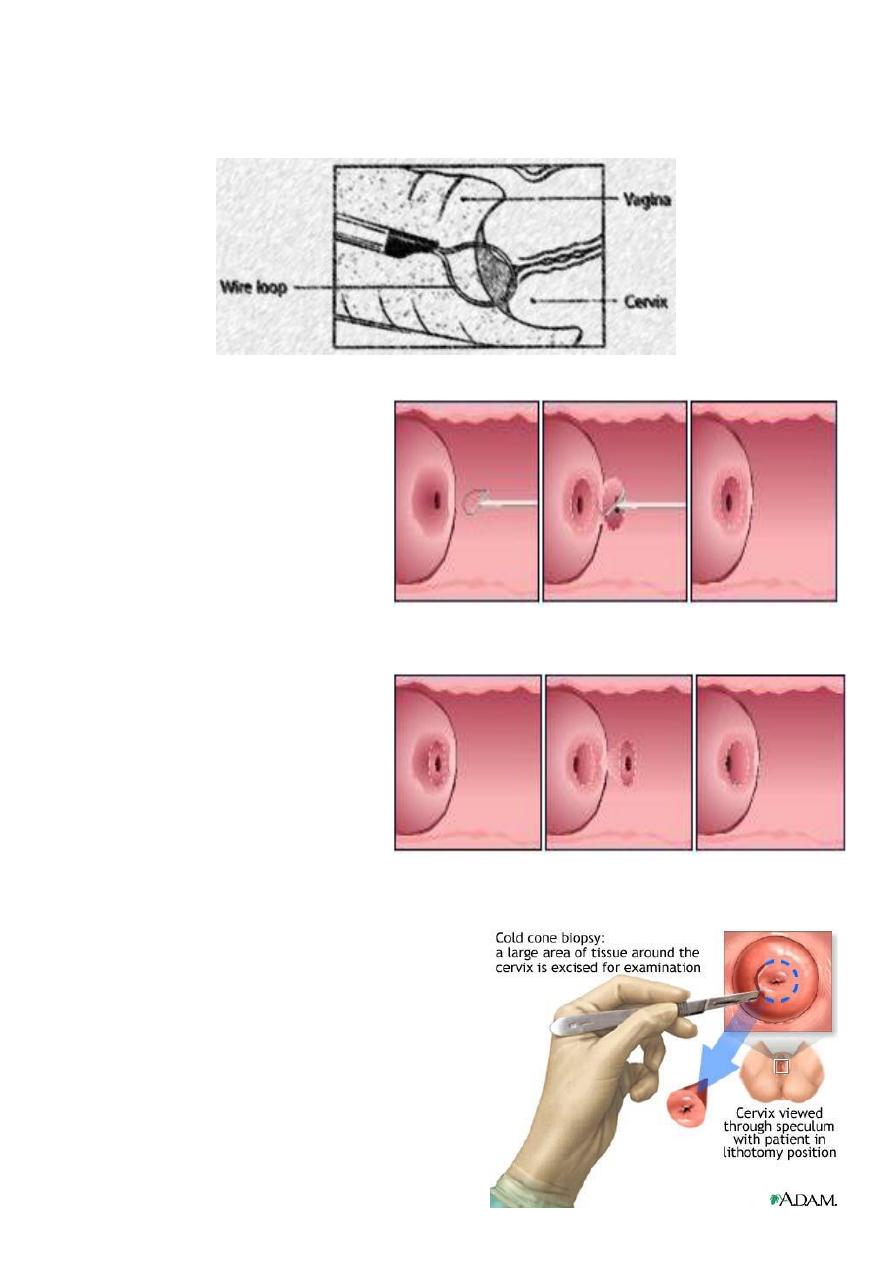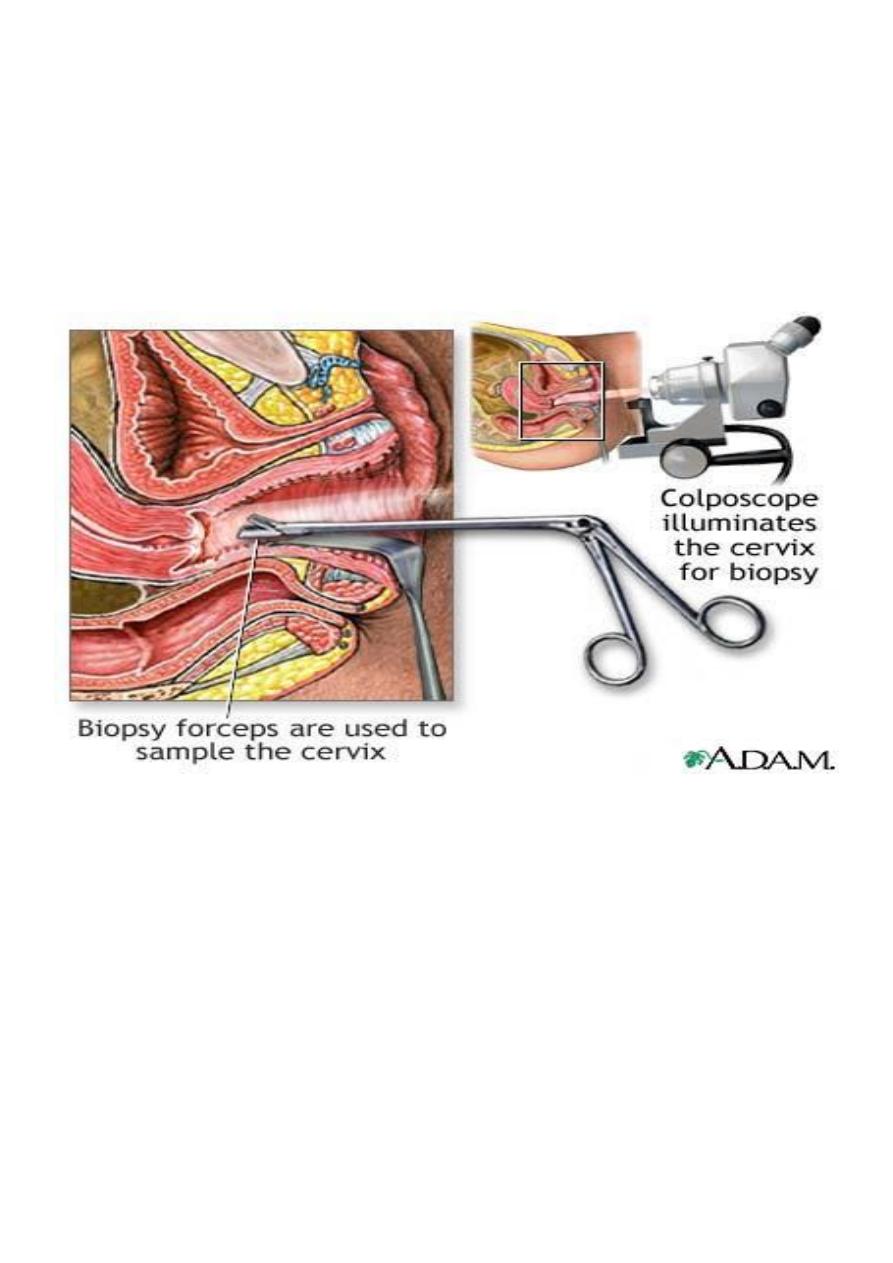
1
Fifth stage
Gynecology
Lec-2
.د
اسماء
15/12/2015
Premalignat disease
Cervical cancer kills about 250000 women a year.
It’s the commonest cause of death from cancer in women .it’s the commonest after
breast cancer.
80% of cases are reported in developing countries.
In developed countries regular screening program has reduced the incidence of cervical
cancer.
Cervical cancer is a preventable disease because of:
1. There is usually a phase of premalignant intra-epitheilial neoplasia with long natural
history.
2. The cervix is a relatively accessible organ to examine.
3. simple test available for the diagnosis of the presence of pre-malignancy.
4. Treatment for pre-invasive disease is highly effective.
Premalignant disease of the cervix:
1.cervical disease
2.Cervical intraepithelial neoplasia
(Cervical dysplasia)
Aetiology:
Human papillomavirus (HPV) infection.
There are 15 high risk type of HPV,type 16-18 is responsible for 70% of cases.type 6 and
11 is associated with cervical condylomata and low grwde CIN.
HPV infection is extremely common and in majority of cases will not lead to
development of cancer. Progression or regression depends on several factors that
interfere with the host's ability to clear the virus such as in.
Transplant patient.
HIV-Positive women.
Smoking.
Adolescent cervix is more susceptible to carcinogenic stimuli because of active process
of squamous metaplasia which occur within the transformation zone.

2
Squamous metaplasia is an physiological process but under the influence of HPV
,cellular alterations occurs that resultatypical transformation zone initiate CIN.
Screening for cervical intraepithelial neoplasia (CIN):
Medical screening method
o Detect premalignant and malignant processes of cervix.
o Prevent progression of abnormal cells to cancer.
o This is NOT a diagnostic test!
Cervical cancer screening with cytology provides the opportunity for early effective
intervention and has reduced morbidity and mortality
Papanicolaou
Cervicoscopey
Visual inspection with acetic acid (VIA)
Visual inspection with acetic acid and magnification (VIAM).
Colposcopy
Cervicography
Automated pap smears
Molecular (HPV/DNA) tests.
Co-testing using the combination of cytology plus HPV DNA testing is an appropriate
screening test for women older than 30 years (applied in some places).
Papanicolaou (Pap) smear test:
Is a screening test for asymptomatic Women to detect treatable pre-invasive squamous
abnormalities of the Cervix
Small number of women will develop invasive Cancer
Not diagnostic-rather screening test to detect early changes on the cervix.

3
Exfoliative cervical cytology was a technique to collect the cells that had been shed
from the cervix.
It is a simple and painless test that may cause minor discomfort.
Cervical Smear aims to prevent cancer, not to detect cancer.
Cervical cancer screening should begin at age 21 years and not before age 21 because it
may lead to unnecessary and harmful evaluation and treatment in women at very low
risk of cancer.
Women who have been immunized against HPV-16 and HPV-18 should be screened by
the same regimen as nonimmunized womenbecause it doesn’t prevent against all high
–risk HPV viral type.
Frequency of cervical cytology screening:
Annual cervical cytology screening is recommended for women aged 21–29 years.
Women aged 30 years and older who have had three consecutive cervical cytology
test results that are negative for intraepithelial lesions and malignancy may be
screened every 2-3 years.
women with any of the following risk factors may still require more frequent cervical
cytology screening:
Women who are infected with human immunodeficiency virus (HIV)
Women who are immunosuppressed (such as those who have renal transplants).
Women who were exposed to diethylstilbestrol in utero.
Women previously treated for CIN 2, CIN 3, or cancer (continue to have annual
screening for at least 20 years).
Pap Smear is not necessary in women in these categories:
Virgin patient.
Total Hysterectomy for benign disease.
Recent result of pap smear.
Age over 65 and over 10 benign Pap Smears.
Preparation:
To prepare for the Pap test, for two days before the test ,women should avoid:
o Vaginal Douching .
o Using tampons.
o sexual intercourse.
o Using birth control foams, creams, or jellies or vaginal medications or creams.

4
the ideal time for a woman to have a Pap Smear is five days after her menstrual period
has ended.
Exfoliated cells are collected from the transformation zone of the cervix by Use spatula
of different size or brush.
There are two methods of preparing and processing cervical smear slides.
These methods are:
1. conventional cervical (Pap) smear test.
collecting the cells smears on a microscope slide and applies a
fixative. The slide is sent to a laboratory for evaluation.
The Spatula with the optimal shape and size is chosen .
Broom type sampler
The 'tongue' of the spatula is introduced into the canal, whilst its 'shoulder' is
positioned on the 3 o'clock position of the ectocervix at the beginning of the procedure
. With gentle pressure the spatula is rotated in a clockwise direction.

5
2. liquid based cytology (LBC) test.
Cell transferred to a vial of liquid preservative
that is processed in the laboratory to produce
a slide for interpretation by light microscopy.
Classification of CIN:
A. CIN classification
CIN 1 (mild dysplasia) involvement of the inner one-third of the epithelium.
CIN 2 (moderate dysplasia) involvement of inner one-half to two-third
CIN 3 (severe dysplasia/carcinoma in situ) full thickness involvement.

6
Or can be classified as:
Low grade lesions (CIN1 and HPV-associated changes) in which there is a significant
chance of regression and low progressive potential.
High grade lesions (CIN 2 and CIN 3) are likely to behave as cancer precursors.
A diagnosis of CIN is based primarily on the presence of nuclear a typia and loss of
normal squamous maturation (polarity).
Accurate grading of CIN lesions becomes important as we begin to understand the
rates of regression, persistence and progression of the low-grade (CIN 1) and high-
grade lesions (CIN 2 and 3), as their treatment and clinical follow-up are quite different.
Cervical pre-cancer has along natural history.
36% of women with CIN3 would develop invasive cancer if left untreated.
More than 40% of women with minor cytological abnormalities will revert to normal
without treatment.
Clinical presentation:
The disease is a symptomatic. The premalignant lesions cause no symptoms and are
not recognizable with the naked eye.
Results of the cervical smear test:
The cytologist will classify the smear accordingly:
Normal results:
Mean that no atypical, dysplastic, or cancer cells were detected, and the cervix is
normal. It is seen in About 9 in 10 routine cervical screening tests.
(Note: a normal result means a very low chance of developing cancer of the cervix - not
a 100% guarantee that it will not occur.)
Abnormal result:
Some changes in the cells are found in about 1 in 10 tests. There is a range of changes
that may occur. In nearly all cases, these changes do not mean cancer.
Inflammatory –excessive leucocytes, candida or trichomonas.
Borderline.( Cellular appearance that cannot be described as normal).
Mild dysplasia

7
Moderate dysplasia.
Severe dysplasia.
Possible invasive carcinoma. Rarely, a cancer of the cervix is diagnosed by a cervical
screening test.
Management of abnormal cervical smears:
Inflammatory smears should be treated by antibiotics or antifungal agents accordingly.
And the smear repeated 3-6 months later.
Border line smear advice to Repeat smear in 6-12 months and refer for colposcopy if
abnormalities persist.
Ideally all women with abnormal cervical cytology(some mild ,moderate ,sever
dysplasia) should have colposcopic assessment to exclude an invasive process and to
identify the extent of abnormality.
Ideally all women with abnormal cervical cytology(some mild ,moderate ,sever
dysplasia) should have colposcopic assessment to exclude an invasive process and to
identify the extent of abnormality.
Any patient with a grossly abnormal cervix should have a punch biobsy regardless of
the results of Papanicolaou smear.
Colposcopy:
It is a binocular operating microscope with
magnification of 5-20 times. Indicated for further investigation of smear abnormalities.
It has been used to examine the cervix in detail to:
*Identify dysplastic abnormalities on the ectocervix.
*Detect changes in the cellular pattern and vascularity of the covering epithelium.
*Allow the accurate localization of the abnormal epithelium.
*Exclude an invasive process.
Colposcopic examination:
We have two methods:
1.Saline method.The cervix and vagina is moistened thoroughly with normal saline in order
to view the vascular pattern.
Gross lesion, vascular details and opacity of epithelium is noticed.
Green filter is used to evaluate the details of vascular epithelium when the blood
vessels appears dark.

8
Occasionally abnormal epithelium will stand out from The surrounding epithelium.
CIN has the potential to be an invasive malignancy but dose not have malignant
properties. High grade lesions (CIN2 and CIN3) should be treated, but there is some
debate about CIN1 they allow CIN 1 lesions to be treated or kept under close
surveillance.
Classical or extended method:
Acetic acid test :After removing the excess mucos , the cervix is liberally moist with a
large swab of loose cotton wool soaked in dilute acetic acid of 3-5%,by this all the
epithelia with high nucleo-cytoplasmic ratio will turn white. this action is transient and
disappear after 1-3 minutes, and it’s better to wait for at least a minute before
recording the acetowhite changes .
Satisfactory colposcopy :The important part of colposcopy is to look for the entire
sequaocoluminar junction and one should be able to see the overlying columinar
epithelium even if it’s inside the cervical canal then to examine the vaginal fornices and
walls.
Tissues with high nuclear activity and high nuclear-cytoplasmic ratio turn white after
application of acetic acid, the faster the aceto whiteness appears and the longer it
persist will reflect the degree of underlying abnormality and more likely to be high
grade intraepithelial lesion
Iodine test:
The cervix and vagina is liberally painted with iodine solution with 50% aqueous solution
because alcohol cause destruction of epithelium.brown staining will occur in glycogen rich
epithelium (sequamous epithelium).
Iodine negative areas occurs in:
Inflammation
Columnar epithelium.
Thin regenerating epithelium.
Immature metaplasia.
Atrophic epithelium
HSIL
Normal colposcopic finding:
Original sequamous epithelium.

9
Pink smooth featureless on the cervix and vagina no
Remnants of columnar epithelium such as gland
Opening Or nabothian cysts . it doesn’t turn white after acetic acid applications and stain
brown after application of lugol’s Iodine.
Sometimes vascular pattern as looped capillaries or as fine net work .
Treatment of CIN:
The treatment for cervical dysplasia must be
individualized for each woman, taking into account:
1. the grade of the dysplasia (CIN1, CIN2, or CIN3).
2. the findings at colposcopy.
3. the woman's age.
4. reproductive status.
5. and other factors.
CIN has the potential to be an invasive malignancy but dose not have malignant
properties. high grade lesions (CIN2 and CIN3) should be treated, but there is some
debate about CIN1 as some allow CIN 1 lesions to be treated and others advice to be
kept under close surveillance..
Treatment involves completely removing the abnormal epithelium.
This can be done by:
1. Destroying the abnormal epithelium.( cryosurgery, laser vaporization)
2. Excisional techniques:(This allows better histopathological interpretation of the
excised specimen).
These techniques include:
a. local excision
b. loop electrode excision procedure (LEEP).
c. cone biopsy.
d. trachelectomy (excision of cervix).
e. hysterectomy.
The success of treatment is usually defined as negative cytology 6 months following
intervention.
Therapeutic vaccination aims to boost host's cell-mediated immunity but still
experimental.

11
Follow up:
Follow up of patient treated for CIN is controversial between colposcopy or cytology.
other tests such as a HPV DNA test may be advocated
LEEP (loop electrosurgical
excision procedure(. After
freezing the area with local
anesthetic, an electrical wire
loop is inserted into the vagina
and all the abnormal tissue is
removed. This procedure is also
done in the physician's office.
A cone biopsy
refers to removal of a cone-
shaped piece of tissue. The
tissue removed provides a
more extensive sample for
diagnosis than a simple biopsy.
A cone biopsy is usually done in
the operating room.
The cold cone biopsy is a surgical
procedure requiring general anesthesia
and is indicated by the presence of
precancerous changes in the cervix .

11
What happens after treatment?
After treatment for dysplasia, patients are followed closely to make sure all the
dysplasia is gone, and that new dysplasia does not occur. Typically, patients are
followed with frequent Pap smears for two years after treatment, e.g. Pap smears
every 3 to 4 months for the first year, and then every 6 months for the second
year. If all the Pap smears come back negative, the patient is be cured, and is then
followed with yearly Pap smears.
A colposcopy-directed biopsy is a procedure in which the cervix is examined with a
colposcope for abnormalities and a tissue sample is taken .
